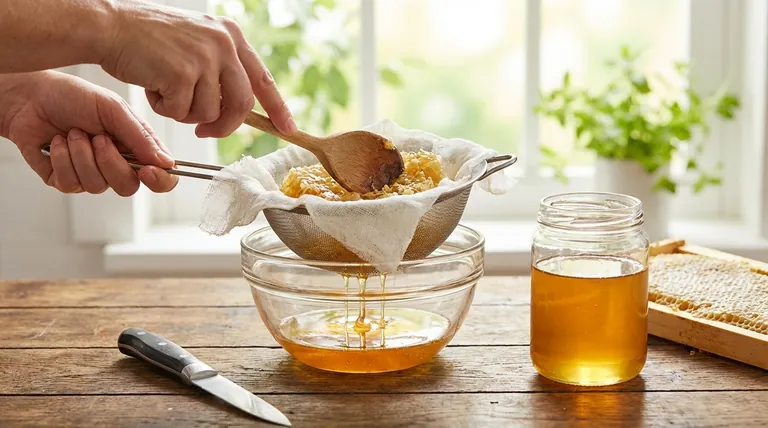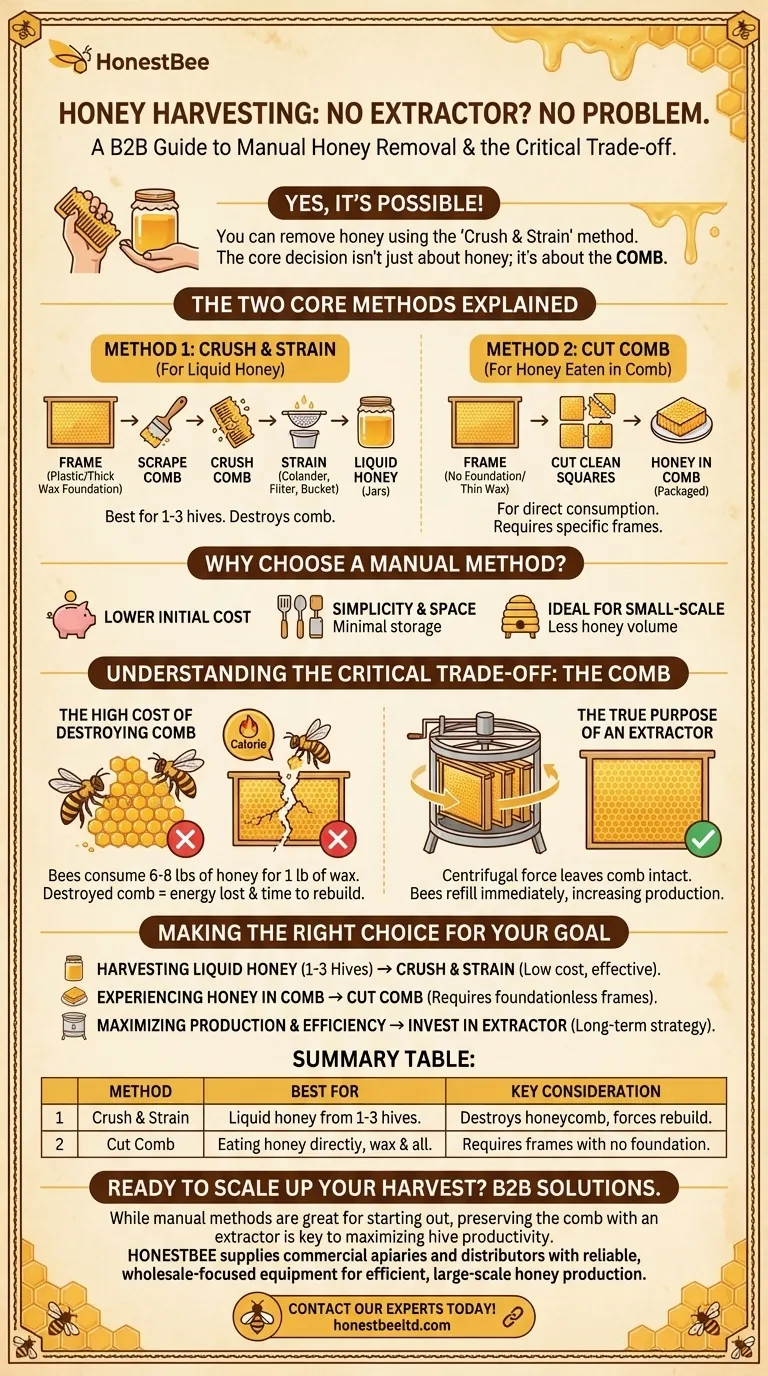Yes, you can easily remove honey without an extractor using a method called "crush and strain." This low-tech approach involves cutting the honeycomb from the frame, crushing it to break open the wax cells, and allowing the raw honey to drain through a filter into a container.
The core decision isn't just about getting the honey out; it's about what you do with the comb. Manual methods like crush-and-strain are simple and cheap but destroy the comb, whereas a mechanical extractor's primary benefit is preserving it.

The Two Core Methods Explained
When forgoing an extractor, you have two primary paths, each suited for a different end product and type of frame.
Method 1: Crush and Strain (For Liquid Honey)
This is the most common and straightforward alternative to mechanical extraction. It’s perfect for harvesting liquid honey that you can store in jars.
The process involves cutting the honeycomb away from the frame supports. For frames with a plastic or thick wax foundation, you will scrape the comb off this central sheet.
Next, you place the scraped comb into a colander lined with a filter cloth (or fine-mesh sieve) set over a clean, food-grade bucket or bowl.
Using a clean tool or your hands, you then crush the comb, breaking up all the wax cells. Gravity will do most of the work as the honey slowly drains through the filter. This can take several hours or even overnight.
Method 2: Cut Comb (For Honey Eaten in the Comb)
This method is less about "extracting" honey and more about harvesting it for direct consumption, wax and all.
This technique is only suitable for frames that have no foundation or a special, extra-thin foundation designed for this purpose.
You simply use a sharp knife to cut clean squares or sections of the honey-filled comb directly from the frame. These pieces are then packaged and eaten as-is, providing the unique experience of chewing the honeycomb.
Why Choose a Manual Method?
Opting for a non-mechanical method comes with several practical advantages, especially for hobbyists.
Lower Initial Cost
Honey extractors are a significant investment. The crush-and-strain method requires only basic kitchen equipment you likely already own, making it financially accessible.
Simplicity and Space
An extractor is another piece of large equipment to clean and store. Manual methods are simple, have minimal cleanup, and require virtually no dedicated storage space.
Ideal for Small-Scale Beekeeping
If you only manage one or two hives, the volume of honey you harvest may not justify the expense and effort of using a large extractor.
Understanding the Critical Trade-off: The Comb
The most significant difference between using an extractor and the crush-and-strain method is the fate of the honeycomb. This is not a minor detail.
The High Cost of Destroying Comb
Bees expend an enormous amount of energy to produce wax and build their comb. It's estimated bees consume 6-8 pounds of honey to produce just one pound of wax.
When you crush and strain, that entire comb structure is destroyed. Your bees must start from scratch, consuming valuable resources and time to rebuild it before they can store more honey.
The True Purpose of an Extractor
A honey extractor uses centrifugal force to sling honey out of the cells while leaving the delicate wax comb almost entirely intact.
Beekeepers can then place these empty "wet" frames back into the hive. The bees can clean them up and immediately begin refilling them with nectar, drastically increasing the hive's potential honey production for the season.
Making the Right Choice for Your Goal
Your ideal method depends entirely on your scale, budget, and beekeeping philosophy.
- If your primary focus is harvesting liquid honey from 1-3 hives with minimal investment: The crush-and-strain method is a perfect and effective starting point.
- If your primary focus is experiencing honey in its most natural state: The cut-comb method is your goal, but ensure you are using frames without a thick foundation.
- If your primary focus is maximizing honey production and minimizing bee labor: Investing in an extractor to preserve the comb is the most efficient long-term strategy.
Ultimately, understanding the trade-off between simplicity and hive efficiency empowers you to make the best decision for your apiary.
Summary Table:
| Method | Best For | Key Consideration |
|---|---|---|
| Crush & Strain | Harvesting liquid honey from 1-3 hives. | Destroys the honeycomb, forcing bees to rebuild. |
| Cut Comb | Eating honey directly, wax and all. | Requires frames with no foundation or a thin, edible one. |
Ready to Scale Up Your Harvest?
While manual methods are great for starting out, preserving the comb with an extractor is key to maximizing your hive's productivity. HONESTBEE supplies commercial apiaries and beekeeping equipment distributors with the reliable, wholesale-focused equipment needed for efficient, large-scale honey production.
Contact our experts today to discuss how our extractors and supplies can help your operation grow.
Visual Guide

Related Products
- 2 Frame Stainless Steel Manual Honey Spinner Extractor for Beekeeping
- 6 Frame Manual Stainless Steel Honey Extractor Beekeeping Equipment
- Electric 8 Frame Honey Spinner Extractor Equipment for Beekeeping
- HONESTBEE 3-Frame Manual Acrylic Honey Extractor
- Commercial Electric 12 Frame Honey Extractor Spinner Motorized Honey Extractor
People Also Ask
- What mistakes should be avoided during honey extraction with a centrifuge? Preserve Your Comb and Honey Quality
- What are some tips for using a honey extractor effectively? Maximize Your Honey Yield and Protect Your Comb
- How do beekeepers harvest honey from the honey super? A Step-by-Step Guide to Efficient Extraction
- How can a pressure washer be used to clean a honey extractor? A Guide to Safe and Efficient Cleaning
- What are some expert tips for cleaning a honey extractor? Protect Your Harvest & Equipment



















